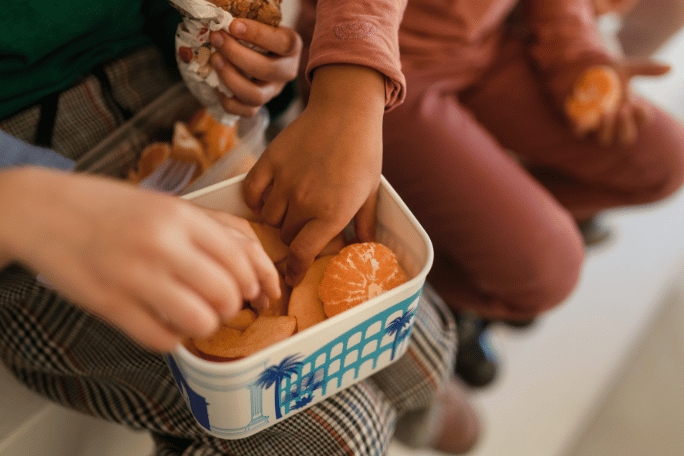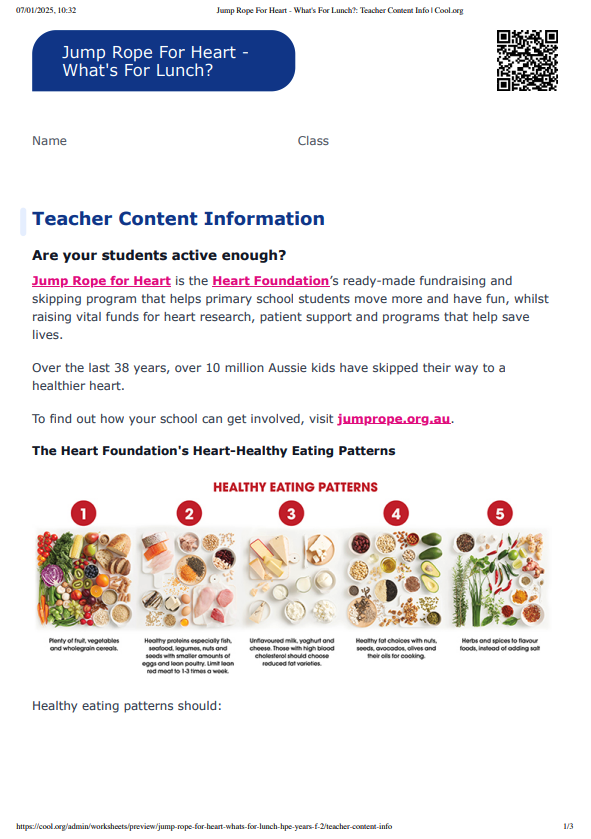Lesson summary
Do places like Brazil and Finland have their own version of the classic Vegemite sandwich? In this lesson, students examine what lunchboxes look like from different parts of the world, and learn how to use healthy eating patterns as a guide for making up their own lunchbox.
Learning intentions:
Students understand...
- our bodies need a variety of foods to stay healthy
- the five parts of the Heart-Healthy Eating Patterns.
Success criteria:
Students can...
- identify familiar ingredients in unfamiliar meals from around the world
- create a meal that is in line with the Heart-Healthy Eating Patterns.
Lesson guides and printables
Curriculum links
Select your curriculum from the options below.
Lesson details
Skills
This lesson is designed to build students’ competencies in the following skills:
- creativity
- critical thinking
- cultural understanding
- adaptability
- global citizenship
Curriculum Mapping
Australian Curriculum content descriptions:
Foundation Year Health and Physical Education:
- Identify actions that promote health, safety and wellbeing (ACPPS006)
Years 1 & 2 Health and Physical Education:
- Recognise situations and opportunities to promote health, safety and wellbeing (ACPPS018)
- Explore actions that help make the classroom a healthy, safe and active place (ACPPS022)
Foundation to Year 2 Visual Arts:
- Use and experiment with different materials, techniques, technologies and processes to make artworks (ACAVAM107)
- Create and display artworks to communicate ideas to an audience (ACAVAM108)
Syllabus outcomes: SLES1.13, PHES1.2, SLS1.13, PHS1.12, VAS1.2, VAS1.1
General capabilities: Critical and Creative Thinking, Intercultural Understanding
Cross-curriculum priority: Asia and Australia’s Engagement with Asia
Relevant parts of Foundation Year Health and Physical Education achievement standards: Students identify actions that help them be healthy, safe and physically active.
Relevant parts of Foundation Year 1 & 2 Health and Physical Education achievement standards: They examine messages related to health decisions and describe how to keep themselves and others healthy, safe and physically active.
Relevant parts of Foundation to Year 2 Visual Arts achievement standards: Students make artworks in different forms to express their ideas, observations and imagination, using different techniques and processes.
This lesson is part of the wider unit of work Jump Rope For Heart: Jump Starters – Years F-2
Time required: 60 mins
Level of teacher scaffolding: High – facilitate class discussion and lead student discovery of content.
Resources Required
- Coloured paper
- Device capable of presenting a video to the class
- Food Flash Cards
- Glue
- Paper plates – one per student
- Scissors
- Whiteboard
Additional Info
Jump Rope for Heart is the primary school skipping challenge that turns kids into Heart Heroes - everyday superheroes who are leading the fight against heart disease. In addition to moving more and having fun, our Heart Heroes raise money to help fund life-saving research that has the power to save Aussie hearts.



Welcome back!
Don't have an account yet?
Log in with:
Create your free Cool.org account.
Many of our resources are free, with an option to upgrade to Cool+ for premium content.
Already have an account?
Sign up with:
By signing up you accept Cool.org's Terms and Conditions(Opens in new tab) and Privacy Policy(Opens in new tab).